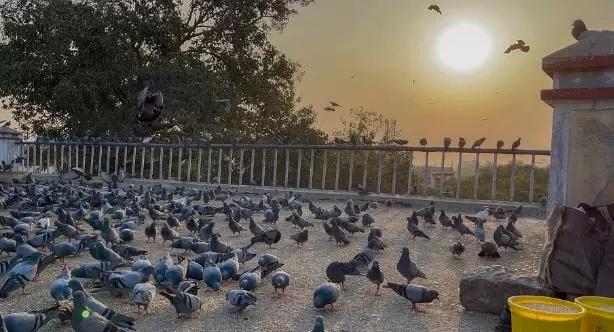Feeding Pigeons at Public Places Raises Traffic and Health Concerns

Hyderabad:A new traffic menace has sprung up in the twin cities. This development is leaving motorists and pedestrians dismayed given that they are at the risk of getting involved in accidents or developing health complications. Quite ironically, the problem stems from a well-intended humane trait.
There are several areas in the city that serve as feeding points for pigeons, including at Muslim Jungpul, Puranapul, Tank bund, Osmania university, Ameerpet and Tarnaka.
Of late, new pigeon feeding points have emerged, largely because of street-smart grain sellers, who have turned this practice into a business. They are drawing more and more people to buy grains, who, in turn, start feeding the birds. Flocks of pigeons are gathering in both the old and new locations and in the process disrupting traffic movement besides raising serious health concerns.
Pigeons that fly at a lower height towards the traffic signals are a hazard to motorists as they lead to accidents.
For instance, Uma, a 37-year-old motorist, stated that she panicked when some pigeons flew low across the road causing her to run into another vehicle.
To add to the traffic problem, pigeons carry diseases that can be transmitted to humans. An increase in the pigeon population near the feeding points also increases health risks. People are unaware of the risks caused by pigeon droppings and their feathers. Although Osmania university authorities have banned feeding of pigeons in the campus, hundreds of pigeons gather daily to be fed and create a mess on the pavements.
Dr P.V.L.N. Murthy, pediatric ENT surgeon, said that bird droppings come laced with fungi, inhaling which can affect one’s immune system. The effects are seen more in children, who report continuous cough and cold thus leading to respiratory problems. Moreover, pigeons can transmit a number of diseases like cryptococcosis, histoplasmosis and psittacosis, among others. One can be infected by these while inhaling dust that is created while cleaning the droppings.
Venkatesh, a grain seller, said that intense competition among them is cutting into their profits. On what happens to the leftover grains on the Tank bund feeding point that pigeons don’t eat, some grain sellers flashed a smile and left the question unanswered. It makes one wonder whether the birds are actually eating those grains.
Anindita Mukherji, a wildlife photographer who promotes nature and animal conservation, noted that many people during their morning walks throw grains for birds believing that feeding birds and dogs brings good luck. This practice invites birds into our environment. Initially only a few birds appear but the continuous availability of grains sees large gatherings of pigeons in due course.
Meanwhile, cashing in on this human sentiment, feeding points are set up to make a fast buck by some grain sellers, especially near temples. They create artificial feeding spots as a source of income. This raises questions about whether the feeding is done out of concern for the birds or merely to earn profits.
Viswa Prasad, additional commissioner of police (traffic) reported that while they successfully clear the grain sellers out, many return within a day or two and set up shop.
With ongoing traffic disruptions and health concerns, people are calling on authorities to take stronger measures to stop pigeon feeding at public places.

